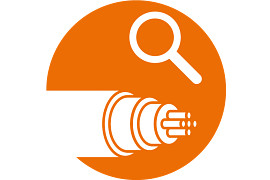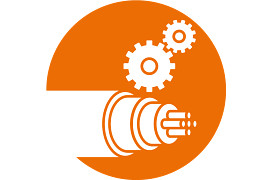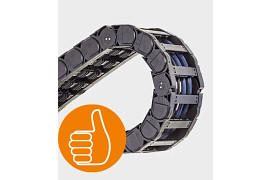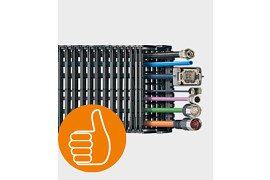Change Language :

Servo cable for the energy chain
In electrical engineering, we speak of a servo cable when we refer to a connection cable for a servo drive. It connects the frequency inverter (FI) and the motor with each other, so to speak. The fact that the FI is the power supply for the motor allows the speed to be changed by adjusting the voltage waveform. This is typically done with pulse-width modulation, which results in high-energy peaks on the voltage curve. Accordingly, the servo cable must also be equipped with a higher voltage class, namely 600V/1000V, and has an overall shield. As servomotors have a temperature sensor and/or a brake, the cable for these functions contains two additional shielded pairs.
Construction of servo cable
There are two different shields in the servo cable. On the one hand, there is the overall shield, which ensures that the electromagnetic compatibility behaviour to the outside is OK. This means that other components of the machine are not disturbed. Secondly, the pairs for the brake and temperature sensor are shielded, which ensures that interference from the power lines does not enter the control circuit of the frequency inverter. These shields are designed differently depending on the mechanical stress. The higher the mechanical stress level of the cable, the higher the quality of the shielding. In practice, this means that the shielding of our high-end cables has a significantly higher mechanical coverage of up to 90%. Furthermore, we use a special winding for the control pairs in the cable that not only has a good electromagnetic compatibility specification, but can also be processed very quickly thanks to its special design.

Why it doesn't always have to be PUR
PUR = chain cable and PVC = fixed installation. This is the conventional wisdom in the cable market. But it's not quite right. We at igus® have tested the different outer sheath materials extensively and for a long time in our cable laboratory and have come to the conclusion that PUR is a very good and flexible material, but does not necessarily always have to be used in the chain.
This is because PVC has far better abrasion properties and is also a cheaper material. However, PUR is indispensable if the cable comes into contact with oil.

servo cable in various applications in the machine tool
One area of application that describes the wide variety of different options for servo cables from the chainflex® programme is that of an interlinked machine tool. Here, the machine is very tight at various axes, so our CF270.UL.D cable series is generally used. The radius used in the main axis is often larger, which saves costs if the CF897 series is used. This series has longer stroke lengths in the stranding and is therefore optimised for a larger bend radius. On the gantry above the interlinked machines, e-chain® is used in long travels and this type of application requires an inner jacket, with which the CF27.UL is equipped, for the high dynamics and sliding use of the chain. All series have a few things in common that are of fundamental importance for a machine tool. Firstly, each cable has UL approval, secondly an oil-resistant outer jacket and thirdly the three-year guarantee with a clear service life statement of up to 10 million double strokes. We should take the path together and develop the cost-effective solution with the help of the wide selection. Please contact our specialists immediately.
Haven't found the right one yet?
Do you already know our online tool?
Easy to find, select the right type, calculate service life and order online

Product finder
Find exactly the right cable quickly

service life calculator
Calculate the service life of any chainflex® cable

Copper surcharge calculator
Calculate the daily copper surcharge

Configurator for customised cables
Configure your customised cable in just 3 minutes

Are you still looking for an energy chain for your cable?
To the energy chains
... or everything ready-made as a readychain®?
To the readychainConsulting
I look forward to answering your questions

Katharina Wielpütz+49 2203 9649 7082Write e-mail
Shipping and consultation
In person:
Monday to Friday from 7 am - 8 pm.
Saturdays from 8 am- 12 pm.
Online:
24h
WhatsApp-Service:
Montag – Freitag: 8 – 16 Uhr